|
Dating Mahabharata War
Two Eclipses in Thirteen Days
Mahabharata war
is considered by many to be a historical event. The epic states that
a singularly ominous pair of eclipses occurred in “Thirteen days”
some time before the war. Using modern astronomical software, this
article shows that a number of “Thirteen day” eclipse pairs were
visible in Kurukshethra. Article suggests some candidate
dates for Mahabharata war.
|
Introduction
Mahabharata is a great epic, and is one of the
pillars of present day Hinduism. The Mahabharata story and its
moral ethos have had profound influence on millions over many
generations. Mahabharata war is said to have occurred before the
transition of Dwapara Yuga to Kali Yuga. Dating the
Mahabharata war and start of Kaliyuga has been elusive and going
on for many centuries.
Aryabhata, is a famous early astronomer with contributions to
science, whose estimate of p, and the time of moon revolution around the
earth are so accurate, that his works are being extensively researched.
Aryabhata (476-550 AD) stated that Kaliyuga started 3600
years before, when he was 23 years old, making the start as 3102 BC [Aryabhateeya
ref-1]). It would date Mahabharata war to around circa 3130-3140
BCJ.
Surya Siddhanta [Ref 2], a document evolved from roughly same
period, states that sun was 54 degrees away from vernal equinox when
Kaliyuga started on a new moon day, corresponding to February 17/18,
3102 BCJ, at Ujjain (75deg47minE 23deg 15min N).
Varaha Mihira (circa 560 AD), another famous astronomer, stated
that 2526 years before start of Saka count (either Shalivahana
saka starting in 79 AD or Vikrama Saka starting in 57 BC) [Brihat
Samhita Ref-3] as per text below.

When Saptarishis (ursa major) was near
Magha Yudhistira was king 2526 years before Saka time
Presently, traditional Sanatana Dharma followers consider that
Kaliyuga started at 3102 BCJ, when Sri Krishna passed away, and that
Mahabharata war occurred in 3138 BCJ. Millennium year 2000 AD is
Kali 5102.
Like Homer’s Iliad, another epic poetry from Greece, different scholars
have expressed opinions varying between the story of Mahabharata
being either total fiction or true record of historical facts. It took
efforts by Schliemann and others to show physical archeological evidence
of existence of Troy in present day Turkey, and Homer’s poems having
historical relevance.
Bharata has been continuously and relatively densely lived in for
thousands of years and in Northern Bharata the archeological
evidence is difficult to come by because of many 100’s of generations of
people living in same area. Hence, it is usual to look for Puranic
and Vedic (written and oral recitation) astronomical evidence to
substantiate the time periods. As is true of all such documents like
bible stories, Scandinavian, Chinese, Japanese, Egyptian and other
documented local folklore, the historical truths are likely to be
anywhere between absolute truth to vivid imagination. An objective
analysis can help in determining the likelihood of folklore being a
historical fact or not.
Mahabharata
Mahabharata epic story was written by,
Vedavyaasa (or Krishna Dwaipaayana) after the Mahabharata
war. Vyaasa is also credited with codifying the existing branches
of Vedas. It is perhaps the longest poem of its kind of such
antiquity. The presently known oldest version of Mahabharata,
based on its style, grammar and other features was probably written down
before the Gupta period. This Mahabharata text does not refer to
any Zodiac’s or Raashis (a western concept probably accommodated
in to Jyotishya some time during 300BC to 200AD). The linguistic
style of the oldest version of Mahabharata clearly cannot be the
basis for determining if and when the events of Mahabharata
occurred. It probably may have been rewritten/re-rendered many times as
the mode of transference was by oral traditions as in the case of
Vedic chandas prosody. The known oldest version has nearly 90,000 to
100,000 poems dominantly with 32 syllables Anushtup chandas, in
18 chapters called Parva’s [ref-4 and 5].
The Bhishma Parva and Udyoga Parva (specific chapters of
Mahabharata) provide considerable astronomical/astrological
descriptions and omens as the Mahabharata war was approaching. It
describes a period of draught, with many planetary positions. Then there
is this clear reference to pair of eclipses occurring on 13th day as
shown below.
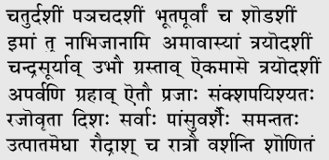
Fourteenth day, Fifteenth day and in past
sixteenth day, but I have never known the Amavasya (New Moon day)
to occur on the thirteenth day. Lunar eclipse followed by solar eclipse
on thirteenth day is in a single lunar month etc…..
This reference to “Thirteen day” eclipse pair
appears to be a unique astronomical observation.
Mahabharata text also refers to retrograde
motions of planets prior to war and provides their location with
reference to 27/28 Vedic star locations. Mahabharata Drona Parva
also refers to Jayadhratha’s killing during a dark episode on
13th day of the war, which some consider as another short solar eclipse.
This document is basically concerned with
analysis of all eclipses visible at Kurukshethra (Location where
Mahabharata war took place, north of New Delhi, Longitude 76 deg
49 min East, Latitude 29 deg 59 Min North) from 3300 BC to about
Buddha-Mahavira-Parshvanaatha time of about 700BC. Analysis of the
time between successive eclipses, specifically time between end of one
and beginning of other has been made, with a view to look at
astronomical feasibility of back-to-back eclipses in 13 days, using
modern astronomical computer software.
Another major issue of how did observers of the period define and
determine period between eclipses when no clocks existed, has been
addressed.
Eclipses
Lunar eclipse occurs when Earth’s shadow falls on
the Moon. There are about 150 lunar eclipses per century. Lunar eclipses
can occur only at full moon, and can be either total or partial. Further
they can be umbral and or penumbral. Total lunar eclipses can last up to
2 hours, while partial lunar eclipses can last up to 4 hours. Any
observer on dark face of earth can see when lunar eclipse when it
occurs. During period 3500BC to 700 BC, nearly 4350 lunar eclipses have
probably occurred. A good fraction of these would have been visible in
Kurukshethra [ref-6].
Solar Eclipse occurs when Moon’s shadow falls on
earth observer. About 240 solar eclipses occur every century. During
period 3500BC to 700 BC, nearly 6960 Solar Eclipses have occurred. Solar
can occur only at new moon. Solar eclipses may be total or annular.
Total solar eclipses can last up to about 8 minutes, and partial solar
eclipses can last up to 115minutes. The shadow of moon has a limited
size of few thousand miles falling on nearly 8000-mile diameter earth.
Hence, solar eclipses can be seen only in a limited range of
longitude-latitude where the shadow falls. Elsewhere, even though sun is
visible, eclipse will not be seen.
Eclipse evaluating computational software and
its validation in present context
Astronomical calculations have been greatly
improved since past 30 years, particularly with considerable amount of
trajectory work conducted in Moon and other scientific projects. High
accuracy computer models and software have been developed. These are
validated against databases from US Naval Observatory’s Interactive
computer Ephemeris, and Jet Propulsion Laboratory in California. One
such code is LodeStar Pro copy righted by Wayne C Annala in 1994 [Ref-
7]. The Lodestar Pro was checked for historical eclipses of 1000-2500 BC
from clay tablet records of Mesopotamia area presently available with
British Museum. Wayne Mitchell has analyzed this data [Ref-8]. Lodestar
Pro provided excellent match with ref-8.
Eclipses at Kurukshethra
During the period of our interest, 3500BC to
700 BC, nearly 4350 Lunar Eclipses and 6960 solar eclipses have occurred
on earth. Of these nearly 673 solar and lunar eclipses occurred in pairs
of time gap of about nominal 15 days corresponding to roughly half lunar
month. We need to search amongst these 673 for eclipse pairs visible in
Kurukshethra, which occurred in “Thirteen” days.
A very detailed scan of all the visible lunar and solar eclipses for
every year from 3300BC to 700 BC was made on the Lodestar software for
Kurukshethra location. These are tabulated and plotted. Maximum
eclipse time gap (end of one eclipse and beginning of next eclipse for
naked eye observers) was found to be about 379 hours while the minimum
was about 332 hours. A plot of time gap between back-to-back eclipses
versus eclipse pair number is shown below. (This time corresponds to
maximum to maximum – not end of one to beginning of next as in the
future table).
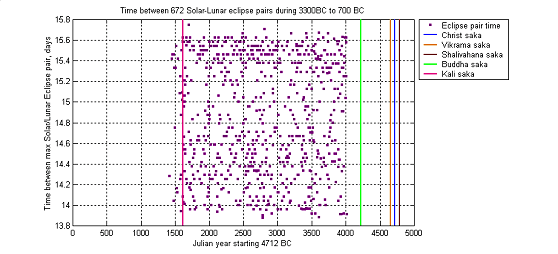
The plot shows that during the period 3300BC to
700 BC, (Julian year corresponds to zero at 4712 BC- an imaginary date-
Our range corresponds to 1412 Julian year to 4012 Julian Year) nearly
672 pairs of eclipses occurred on earth, which in principle may have
been visible at Kurukshethra. Amongst these, nearly 32 pairs
would be occurring for period less than 14 days. Many of these were
found to be weak penumbral eclipses of moon, and solar eclipses had such
low obscurity as to raise the issue whether any body could see them. Six
pairs of “thirteen day” eclipses could be seen unambiguously.
Definition of Day and issue of timing
determination
It is easy for us, in present time, to
precisely analyze the eclipse times based on a 24 hour per day time
clock. However many thousand years ago, such a time evaluation would
clearly be irrelevant. Hence the count of the day and time had to be
based on clear, natural and unambiguous events such as sunset to sunset
or sunrise to sun rise. Hence in all the analyses, presented below, the
time of relevant sun rise or sun set is indicated such that the eclipse
beginning and end can be evaluated with reference to the sun rise or sun
set. In modern day definition, the period from sunrise to next sunrise
is never 24 hours except on equinox day. On all other days, the time
will be either less than 24 hours (when day light time is shrinking) and
more than 24 hours (when day light time is increasing). For people of
ancient times, sunset-to-sunset or sunrise-to-sunrise would be the
logical definition of a day. Using this definition, it is possible to
determine whether an eclipse pair occurred in “Thirteen days”.
Kurukshethra eclipses and some planetary
retrograde motions
The table below shows six pairs of eclipses,
which can be analyzed further to determine whether Mahabharata war and
events could occur then.
Six eclipse pairs visible at Kurukshethra occurring in less than
or near 14 days
Events in red not visible due to sun
rise (Lunar) or sun set (Solar)
Year BC Eclipse Julian day Initial con Max End
Sunrise Sunset end/start date
|
Year BC |
Eclipse |
Julian
Day |
Initial
Con |
Max |
End |
Sunrise |
Sunset |
End/Strt
Dt |
|
3129 |
Solar |
Aug 11 |
18:53:48 |
19:48:04 |
20:38:54 |
|
19:22 |
13d20h20m |
|
3129 |
Lunar |
Aug 25 |
16:58:50 |
18:21:36 |
19:44:21 |
|
19:17 |
|
|
2529 |
Solar |
Jul 11 |
03:50:53 |
04:36:27 |
05:24:36 |
05:12 |
|
13d20h8m |
|
2529 |
Lunar |
Jun 27 |
03:29:54 |
05:13:45 |
06:57:36 |
05:07 |
|
|
|
2056 |
Solar |
Nov 25 |
16:50:19 |
17:52:24 |
18:48:02 |
|
17:38 |
13d21h40m |
|
2056 |
Lunar |
Dec 09 |
16:27:47 |
18:12:55 |
19:58:05 |
|
17:32 |
|
|
1853 |
Solar |
Dec 30 |
15:47:28 |
17:00:02 |
18:03:38 |
|
17:29 |
13d22h14m |
|
1853 |
Lunar |
Jan 13 |
16:17:56 |
17:24:16 |
18:30:37 |
|
17:36 |
|
|
1708 |
Solar |
Mar 27 |
04:55:14 |
05:47:28 |
06:44:15 |
06:37 |
|
13d20h18m |
|
1708 |
Lunar |
Apr 10 |
03:02:36 |
04:46:36 |
06:30:55 |
06:19 |
|
|
|
1397 |
Solar |
Jul 04 |
19:00:34 |
19:36:54 |
20:11:34 |
|
19:21 |
13d21h30m |
|
1397 |
Lunar |
Jul 18 |
17:41:38 |
19:34:00 |
21:26:30 |
|
19:23 |
|
Location of Kurukshethra 76deg49 min East, 29deg 59min North
After serious analysis
of all the eclipses, six eclipse pairs from
3129 BCJ, 2599 BCJ, 2056 BCJ, 1853 BCJ,
1708 BCJ and 1397 BCJ
clearly are the best
candidates for Mahabharata war year from “thirteen day” eclipse
pairs view point. There are others that have low obscurity for solar
eclipse, or have dominant penumbral lunar eclipse content and hence do
not constitute strong candidates for the Mahabharata war.
One typical eclipse pair of the six is illustrated using Lodestar Pro
views of the relevant sunset/sunrise periods. The light/day transition
is clearly shown in all the eclipse, which would form the only method of
determining that the eclipses occurred in less than fourteen days, which
has to be called thirteen-day eclipses. Planets Sani (Saturn) and
Brihaspati (Jupiter), Shukra (Venus) in retrograde motion
are illustrated for period around the eclipse pairs.
Solar-Lunar eclipse pair from Julian year 3129BC
|
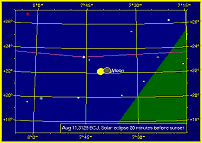 |
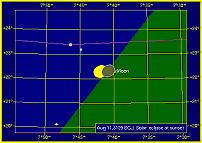 |
|
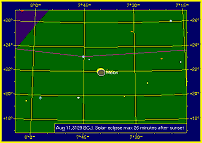 |
|
Fourteen
days later at same time |
|
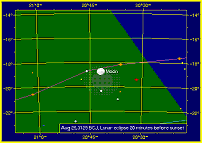 |
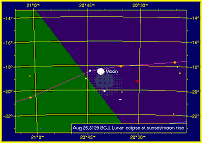 |
|
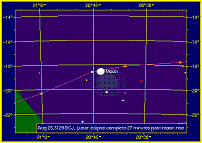 |
Let us now look at how any observer can study
these eclipses and conclude that the pair occurred in “Thirteen days”.
The figures above show the pictures of day/night sky for a pair of
Solar-Lunar eclipses, end of lunar eclipse being only 13 days and 20
hours before start of a solar eclipse. On Julian August 11 afternoon, a
solar eclipse begins 20 minuets before sunset and it is still on going
at sunset. Fourteen days later (On Julian August 25) in the evening at
sunset a lunar eclipse is already occurring. It clearly suggests that
eclipse started on the 13th day after the previous eclipse! Obviously
the end of lunar and start of solar eclipses were less than 14 days
period, or occurred in 13 days. This could be concluded without the
benefit of modern clocks.
The dates of this eclipse pair are Julian 3129 and Julian month of
August. In ancient Bharata, since the full moon occurred on
Proshtapada, the month would be considered as Bhadrapada.
Normally, this is the monsoon rainy season in North India. However,
there are many occasions when monsoon fails. The epic states that
draught like conditions existed. Even during normal monsoon the sky is
occasionally clear for the eclipses to have been witnessed.
The two planets Jupiter, and Saturn are in motion (vakri) and
these do occur during 3129 JBC as illustrated below. Motion of
Angaraka or Mars is normal.
Items in
red show retrograde or Vakri motion
|
Graha
(Planet) |
3129BCJ |
Mahabharata text |
|
Brihaspati
(Jupiter) |
U.Ashada/Shravana |
Shravana-Vishakha |
|
Sani
(Saturn) |
Revati |
Shravana-Vishakha |
|
Angaraka
(Mars) |
U.Ashada/Shravana |
Magha |
|
Shukra (Venus) |
U
Phalguni |
Poorva Phalguni |
|
Ravi
(Sun Solar) |
U Phalguni |
Rohini |
The location of the planets at the time of
eclipse pair is shown in table above. Clearly, only Brihaspati,
and Shukra are the only planets near locations indicated in the
Mahabharata text. This date of 3129 BCJ is a serious candidate
date for consideration of Mahabharata war.
Analysis of the Eclipse tables.
The first and oldest eclipse pair
from 3129 BC is unique. Aryabhata estimated
that Kaliyuga started in 3102 BC. So does Surya Siddhanta.
These fit the Puranic description that Sri Krishna passed away in
3102 BCJ, which is 27 years after the war. Our study confirms that
Kaliyuga could have started in 3102 BCJ.
The second date 2559 BCJ
is also unique in that Varaha Mihira stated
that 2526 before start of Saka, Yudhishtira was the ruling
king. If it Saka was Vikrama it would make Yudhistira
as king in 2583 BCJ, which is before Mahabharata War.
Yudhistira was also king for a short time before war, before he lost
it in a game of dice to Sakuni/Duryodhana. This date is also an
excellent candidate for Mahabharata war. There is another event
that occurs in 2559 BC. While the eclipse pair occurred in lunar month
Shravana, there is another short solar eclipse in Pushya.
On 13th day of Mahabharata war, it is said that Jayadhratha
was killed when Sri Krishna covered the sun for a short time just before
the sunset. This event could be looked upon as a solar eclipse. A study
of year 2559 shows that another solar eclipse did occur in Pushya
lunar month (Julian Dec 06, 2559) some 40 days before the winter
solstice (Uttara ayana).
The third candidate
is eclipse pair from 2056 BCJ. It occurs in
Margashira/pushya months, the lunar eclipse occurring when moon is
between Punarvasu/pushya nakshathra, and would be right in the
middle of war. Hence is not a very serious candidate for Mahabharata
war.
The fourth candidate
is eclipse pair from 1853 BCJ. It occurs in month
of Magha very near the winter solstice or Uttara Ayana. It
is not a very good candidate for Mahabharata War
The fifth candidate
of eclipse pairs occurred in 1708 BCJ. This
eclipse pair occurs in month of Phalguna, just after Uttara
Ayana and is a bad candidate.
The last candidate
of eclipse pair occurs in 1397 in the month of
Bhadrapada. It is a reasonably good candidate for Mahabharata war.
Again, there was no solar eclipse during the period prior to Uttara
Ayana.
Conclusions
The aim of this work was to analyze the unique
statement that Mahabharata war took place when an ominous pair of
eclipses occurred in “Thirteen days”. Initially, Mahabharata
texts, contemporarily accepted as most authentic were reviewed and
relevant data about Mahabharata and astronomical planetary
observations have been presented.
Firstly, a search of all eclipses during the period 3300 BCJ to 700 BCJ
visible at Kurukshethra, where Mahabharata war took place
was made. Amongst nearly 672 possible eclipse pairs, the time from end
of one to beginning of next eclipse was found to vary between 13.8 days
to 15.8 days. Eighteen naked eye visible eclipse pairs with less than
336 hours (14days) of time gap were found.
The second issue was, what was the definition of a day, and how was the
determination that eclipses occurred in “thirteen days” made, has been
addressed. Day was taken to be the time between either successive
sunrise or successive sunset. This is particularly important when clocks
did not exist. Using this method, it was easy to demonstrate that
observers from 3000 to 5000 years ago could identify accurately a
“Thirteen-day” eclipse pair when they occurred.
Six pairs amongst these, found to be good candidates for Mahabharata
war, have been illustrated, showing how any observer could conclude
that the eclipse pairs occurred in less than 14 days or in “thirteen
days”. The locations of Jupiter, Saturn, Mars, Venus, Sun and Moon,
during the eclipses were identified with reference to 27 star locations.
The positions of all these planets during the eclipse pair do not
totally agree with Mahabharata text, but some do agree.
Finally, it is found that two dates suggested
by Indian astronomers Aryabhata, Varaha Mihira are credible dates
for Mahabharata war. It would appear that 3129 BCJ is a first
candidate for Mahabharata war followed by 2559 BCJ. Four other dates
viz., 2056 BCJ, 1853 BCJ, 1708 BCJ and 1397 BCJ are other candidates
which qualify as “ Thirteen day” eclipse pairs.
In conclusion, this article has tried to address the basic issue,
whether “ Thirteen day” eclipse pairs are astronomically possible. The
conclusion is that such eclipse pairs have occurred and observers could
easily identify the duration using sunset/sunrise transitions. 3129 BCJ
and 2559 BCJ dates appear to be very viable dates for Mahabharata
war as are a few others. This study provides modern scientific support
one critical astronomical statement made in Mahabharata Bhishma Parva
that “Thirteen day” eclipse pair occurred in Kurukshethra before
the Mahabharata war.
References :
1.
Aryabhateeya by
Brahmagupta, S.Shukla,New Delhi, INSA 1976
2.
Surya Siddhanta:
Translation of an Ancient Indian Astronomical Text.
Translation by Bapudeva, Varanasi, 1860.
3.
Varahamihira’s
Brihat Samhita- M Ramakrishna Bhat, Motilal Banarasidas Publications,
1981
4.
Ramashesha
Shastry Bhagavata Mahapurana,
10th skanda, Upodghata (in Kannada script), 1930
5.
John Smith web
page - Mahabharata Text checked by Bhandarakar Oriental Research
Institute
6.
Eric Weisstien,
World Of Astronomy web page
7.
Wayne Annala,
Lodestar Pro Manual, 1994
8.
Wayne Mitchell
Ancient Astronomical Observations and Near Eastern Chronology
Journal of Ancient Chronology Forum, Volume3
|

